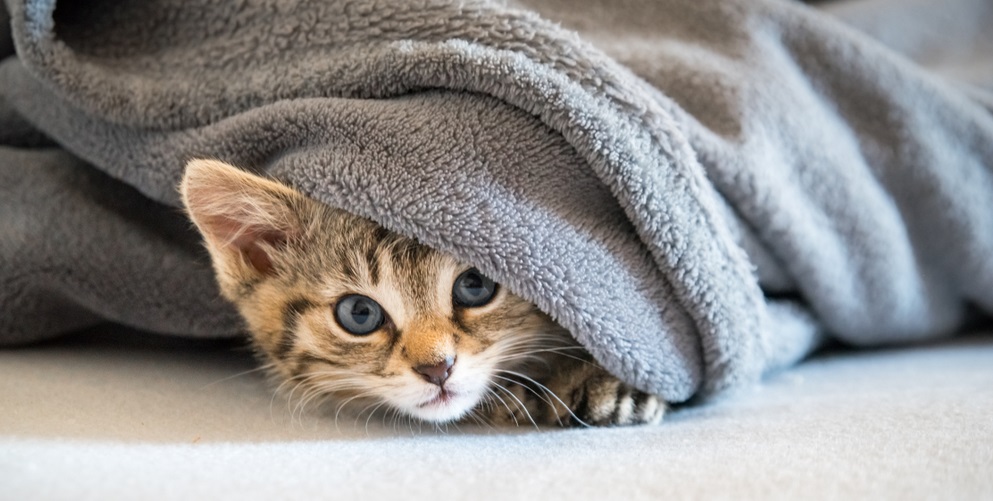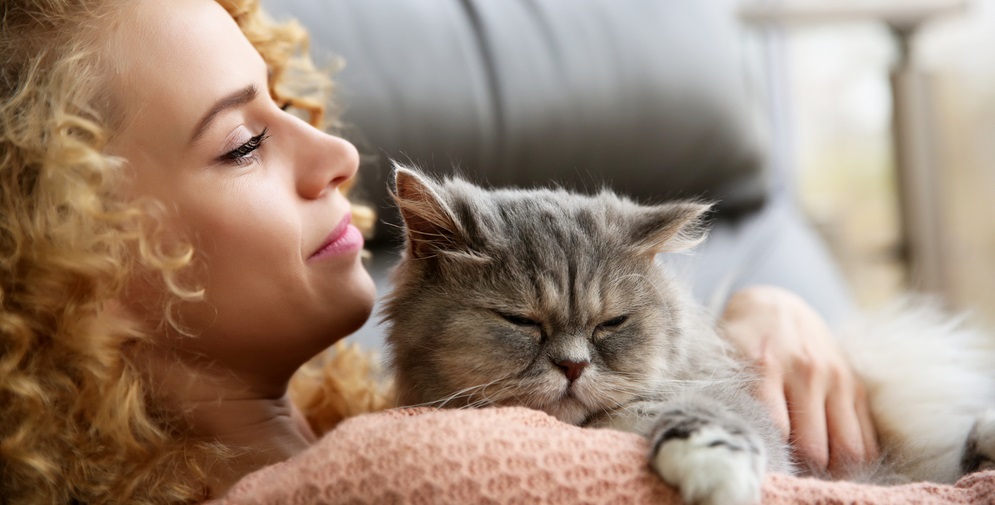As a cat owner, you’re likely well-versed in cat communication—a tail pointed straight in the air means your furry friend is happy to see you, paws the knead your favorite blanket mean they’re ready to relax, and a forlorn rrrooooowwwwrrrrr in front of the food bowl means…well, we all know what that one means.
But what does it mean when your cat is winking, blinking, or squinting at you? This isn’t some sort of secret kitty code. It’s actually a sign that your cat is experiencing dry, irritated, or infected eyes. In fact, eye problems are common among our feline companions. And, just like human eye issues, cat eye issues can be either a temporary nuisance or a sign of a more serious medical condition.
In this guide, we’ll detail some of the most common feline eye problems, including symptoms to look out for, as well as tips for treatment and prevention.
The Trifecta of Feline Eye Problems
Whether you’re tangling with kitten eye problems or ocular maladies in older cats, feline eye issues generally fall into one of three categories:
- Conjunctivitis – A bacterial infection with several causes.
- Aging eyes – A natural part of your cat’s life cycle.
- Congenital issues – Problems your cat is born with.
Luckily, cat eye problems in all three of these categories are usually treatable. While congenital issues or problems that present in old age may not be reversible, they can still be managed so that your cat can keep on enjoying all the snuggles, treats, and toys you have to offer.
So, let’s take a look at the details of each.
Conjunctivitis
There might come a day when you see your cat and wonder, “Why are my cat’s eyes watering?” Or “Why are my cat’s eyes red?” Or “Why is my cat’s eye swollen?” It is most likely caused by conjunctivitis. Most cat eye problems can be attributed to a bacterial infection called conjunctivitis, otherwise known as “pink eye.” That’s right—the same pink eye that may have plagued your elementary school classroom can also plague your fur baby. In fact, most cats will experience at least one bout of conjunctivitis in their lifetime, no matter how meticulously they’re cared for.1
During a conjunctivitis infection, conjunctiva—the thin membrane that coats the outside of the eyeball and the inside of the eyelids—becomes irritated, causing one or all of the following symptoms:
- Gooey discharge
- Excessive blinking
- Squinting
Ideally, whenever your cat has any of these symptoms, you should head to the vet. However, if you can’t do so on short notice, you might be wondering, “How can I treat my cat’s eye infection at home?” If your cat is presenting one or more of these symptoms, Vetericyn Plus Antimicrobial Eye Wash can provide irritation relief. Not only is the eye wash soothing, but it also cleans the fur around the eyes to prevent further contamination of the conjunctiva with the bacteria that caused the infection in the first place.
Despite the relief this eyewash can provide, it may not treat the underlying cause of your cat’s conjunctivitis infection, so it’s still important to schedule a visit to your vet. Your vet will examine your cat and their symptoms to determine the underlying cause of the infection and recommend a treatment plan, such as prescribing an eye drop.
Conjunctivitis is typically caused by either the feline herpes virus, a bacterial infection, or environmental irritants.
Feline Herpes Virus
The feline herpes virus (FHV) affects more than 90% of cats,2 making it the most common cause of cat conjunctivitis.3 Like the herpes simplex virus in humans, FHV spreads between cats during the disease’s incubation period, which usually lasts between two and five days.
Cats are only contagious during this incubation period, but symptoms of the virus can last for 10 to 20 days after they’ve been infected. One of these symptoms is conjunctivitis, characterized by discharge, excessive blinking, and squinting.
Although FHV cannot be cured, conjunctivitis caused by FHV can be treated with eye antiviral eye drops or oral medication.
Bacterial Infection
Conjunctivitis can also be caused by a bacterial infection, which can be both diagnosed and treated by your vet. Common bacterial infections include:4
- Salmonella
- Streptococcus
- Toxoplasmosis
- Bordatella
Bacterial infections can arise for any number of reasons. Your vet is best equipped to identify the cause and remedy the infection, as well as the accompanying conjunctivitis. Typically, your vet will recommend antibiotics to treat a bacterial infection.
But the best treatment for bacterial infections? Prevention. With the Vetericyn Plus Feline Antimicrobial Facial Therapy, you can clean and soothe existing bacterial infections and help prevent future infections of your cat’s eyes, mouth, and ears by keeping the area clean and irritation-free. It’s antibiotic- and steroid-free, so that you can use it as a supplement to your vet’s antibiotic treatment and as a safeguard against future infections.
Environmental Irritants
Kitten eye issues are especially common immediately after adoption, and conjunctivitis is no exception. One potential cause of conjunctivitis in cats (especially those that are newly adopted) is environmental irritants, such as:
- Fragrant air fresheners
- Scented laundry detergents
- Dust
- Pollen from seasonally-blooming plants
If your vet determines that your cat’s conjunctivitis is due to environmental irritants, consider ditching scented products, dusting more frequently, or using an air purifier during allergy season to help protect your cat’s eyes.
Aging Eyes
If your feline friend is entering their golden years, you may begin to notice some cat eye problems that didn’t impact them in their youth.
Some ubiquitous signs of feline eye problems in older cats include:
- Clumsiness
- Visible irritation or discomfort
- Visual changes to their eyes
If you notice any of the above in your aging cat, your vet may diagnose them with glaucoma, cataracts, or a dry eye disorder.
Glaucoma
When your cat’s aqueous humor—the watery part of the eye immediately behind the lens—can’t drain properly, they can develop glaucoma.5 This is because when the aqueous humor can’t drain, it puts pressure on the eyes, which can result in visual impairment or even blindness (just like human glaucoma).
Glaucoma presents as general swelling or progressive clouding of the eyes. While the condition isn’t curable, your vet can prescribe medications to reduce swelling and relieve your cat’s eye pain.
Cataracts
Feline cataracts present similarly to glaucoma, and both result in progressively cloudy eyes. Cataracts, however, can be caused by a variety of factors, including:6
- Injury to the eye
- Bacterial infection
- Nutritional deficit
- Infection
- Cancer
If you notice any clouding in your cat’s eyes, reach out to your vet to schedule an appointment. While some cats may qualify for cataract surgery, others will be given steroids and anti-inflammatory eye drops to relieve their visual discomfort.
Dry Eye Disorder
One of the most common feline eye problems among older cats, dry eye disorder, is exactly what it sounds like. As cats age, they can develop dry eyes, which can lead to:
- Brown or clear discharge (from one or both eyes)
- Squinting
- Irritation
Fortunately, your vet can prescribe eye drops to artificially supplement your cat’s tear production, reduce their discomfort, and keep those adorable eyes moist.
Congenital Issues
Between their enchanting eyes, the plushy softness of their fur, and their unique markings, your cat’s got some pretty cute genes. But those genes may also be the culprit behind irritating eye issues.
Congenital feline eye problems—eye problems your cat was born with—can present at any point during your cat’s lifetime, impacting their vision, comfort, and mood.
Luckily, congenital issues are usually treatable. Take a look below at some of the most common.
Allergies
Like humans, cats can be genetically predisposed to developing allergies. Cat eye problems may arise from a variety of allergies, but some include:
- Seasonal allergies to pollen or other plant matter
- Food allergies to common ingredients in pet food
- Environmental allergies to detergents, soaps, or other scented products in a cat’s home
Depending on your cat’s specific allergy, your vet may recommend using an air purifier, switching to a new food, or changing laundry detergents to avoid future exposure to the offending allergens.
However, allergens can be sneaky, so if your cat develops a rash or other skin irritation due to an allergy, try applying Vetericyn Plus Feline Antimicrobial Hydrogel to the affected area. This non-toxic hydrogel can help alleviate rashy, itchy skin, and provide protection to speed up the healing process.
Ocular Dermoids
Ocular dermoids are small lumps in or around feline eyelids. They’re congenital, but they’re also genetically transmitted. They usually present as kitten eye problems when cats are young.
Humans are also subject to ocular dermoids, and while they’re usually painless, they can be a bit unsightly. Luckily, ocular dermoids can be removed surgically, so any signs of lumps around your cat’s eyelids should be reported to your vet as soon as possible.7
Eyelid Agenesis
When cats are born with an underdeveloped upper eyelid—a condition called eyelid agenesis—they can become prone to infections and irritation. Since their upper eyelids aren’t developed, cats with eyelid agenesis cannot perform complete blinks, which can cause their eyes to become dry and infected. Plus, without the protection of fully developed eyelids, the fur growing around their eyes can irritate their conjunctiva and create additional discomfort.
There are a variety of treatments for eyelid agenesis, including:
- Surgical repair of the eyelids
- Prescription eye drops to keep cats’ eyes moist and protected
- Removal of fur around the eyes
Vets and cat parents can work together to determine the best treatment option depending on financial considerations and desired outcomes.8
Avoid Cat Eye Problems with Vetericyn Preventative Care
While conjunctivitis can be a hassle, aging cat eyes are inevitable, and congenital issues are unavoidable, feline eye problems can usually be treated or managed. But, in the case of bacterial or viral infections, prevention and treatment go hand-in-hand.
At Vetericyn, we’ve pioneered prevention, treatment, and wellness solutions tailored to your cat’s health, comfort, and happiness. Our innovative line of pet-safe formulas can help prevent some of the most common cat eye problems. Whether your cat is in the throes of a pesky conjunctivitis flare-up or they won’t stop scratching at their seasonal allergy rash, Vetericyn is here to help.
Check out our line of soothing, non-toxic feline care products today, and see the difference in your cat’s comfort level for yourself.
Sources:
- Cornell Feline Health Center. Conjunctivitis. https://www.vet.cornell.edu/departments-centers-and-institutes/cornell-feline-health-center/health-information/feline-health-topics/conjunctivitis
- My Vet Candy. What you need to know about feline herpes virus. https://www.myvetcandy.com/clinicalupdblog/2020/2/14/what-you-need-to-know-about-feline-herpes-virus#:~:text=Feline%20Herpes%20Virus%20(FHV)%20is,90%25%20of%20the%20cat%20population.
- VCA Animal Hospitals. Herpesvirus Infection in Cats (Feline Viral Rhinotracheitis). https://vcahospitals.com/know-your-pet/feline-herpesvirus-infection-or-feline-viral-rhinotracheitis
- National Animal Supplement Council. Bacterial Infections and Cats. https://www.nasc.cc/pet-university/bacterial-infections-and-cats/
- Cornell Feline Health Center. Feline Glaucoma. https://www.vet.cornell.edu/departments-centers-and-institutes/cornell-feline-health-center/health-information/feline-health-topics/feline-glaucoma
- VCA Animal Hospitals. Cataracts in Cats. https://vcahospitals.com/know-your-pet/cataracts-in-cats
- National Library of Medicine. Ocular dermoids in 13 cats: a multicentre retrospective study. https://pubmed.ncbi.nlm.nih.gov/34519242/
- MSPCA. Feline Eyelid Agenesis. https://www.mspca.org/angell_services/feline-eyelid-agenesis/

